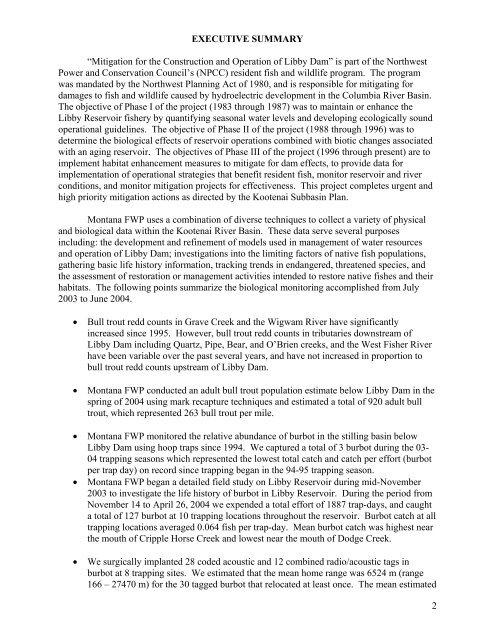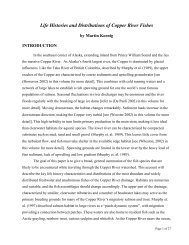Mitigation for the Construction and Operation of Libby Dam
Mitigation for the Construction and Operation of Libby Dam
Mitigation for the Construction and Operation of Libby Dam
Create successful ePaper yourself
Turn your PDF publications into a flip-book with our unique Google optimized e-Paper software.
EXECUTIVE SUMMARY<br />
“<strong>Mitigation</strong> <strong>for</strong> <strong>the</strong> <strong>Construction</strong> <strong>and</strong> <strong>Operation</strong> <strong>of</strong> <strong>Libby</strong> <strong>Dam</strong>” is part <strong>of</strong> <strong>the</strong> Northwest<br />
Power <strong>and</strong> Conservation Council’s (NPCC) resident fish <strong>and</strong> wildlife program. The program<br />
was m<strong>and</strong>ated by <strong>the</strong> Northwest Planning Act <strong>of</strong> 1980, <strong>and</strong> is responsible <strong>for</strong> mitigating <strong>for</strong><br />
damages to fish <strong>and</strong> wildlife caused by hydroelectric development in <strong>the</strong> Columbia River Basin.<br />
The objective <strong>of</strong> Phase I <strong>of</strong> <strong>the</strong> project (1983 through 1987) was to maintain or enhance <strong>the</strong><br />
<strong>Libby</strong> Reservoir fishery by quantifying seasonal water levels <strong>and</strong> developing ecologically sound<br />
operational guidelines. The objective <strong>of</strong> Phase II <strong>of</strong> <strong>the</strong> project (1988 through 1996) was to<br />
determine <strong>the</strong> biological effects <strong>of</strong> reservoir operations combined with biotic changes associated<br />
with an aging reservoir. The objectives <strong>of</strong> Phase III <strong>of</strong> <strong>the</strong> project (1996 through present) are to<br />
implement habitat enhancement measures to mitigate <strong>for</strong> dam effects, to provide data <strong>for</strong><br />
implementation <strong>of</strong> operational strategies that benefit resident fish, monitor reservoir <strong>and</strong> river<br />
conditions, <strong>and</strong> monitor mitigation projects <strong>for</strong> effectiveness. This project completes urgent <strong>and</strong><br />
high priority mitigation actions as directed by <strong>the</strong> Kootenai Subbasin Plan.<br />
Montana FWP uses a combination <strong>of</strong> diverse techniques to collect a variety <strong>of</strong> physical<br />
<strong>and</strong> biological data within <strong>the</strong> Kootenai River Basin. These data serve several purposes<br />
including: <strong>the</strong> development <strong>and</strong> refinement <strong>of</strong> models used in management <strong>of</strong> water resources<br />
<strong>and</strong> operation <strong>of</strong> <strong>Libby</strong> <strong>Dam</strong>; investigations into <strong>the</strong> limiting factors <strong>of</strong> native fish populations,<br />
ga<strong>the</strong>ring basic life history in<strong>for</strong>mation, tracking trends in endangered, threatened species, <strong>and</strong><br />
<strong>the</strong> assessment <strong>of</strong> restoration or management activities intended to restore native fishes <strong>and</strong> <strong>the</strong>ir<br />
habitats. The following points summarize <strong>the</strong> biological monitoring accomplished from July<br />
2003 to June 2004.<br />
• Bull trout redd counts in Grave Creek <strong>and</strong> <strong>the</strong> Wigwam River have significantly<br />
increased since 1995. However, bull trout redd counts in tributaries downstream <strong>of</strong><br />
<strong>Libby</strong> <strong>Dam</strong> including Quartz, Pipe, Bear, <strong>and</strong> O’Brien creeks, <strong>and</strong> <strong>the</strong> West Fisher River<br />
have been variable over <strong>the</strong> past several years, <strong>and</strong> have not increased in proportion to<br />
bull trout redd counts upstream <strong>of</strong> <strong>Libby</strong> <strong>Dam</strong>.<br />
• Montana FWP conducted an adult bull trout population estimate below <strong>Libby</strong> <strong>Dam</strong> in <strong>the</strong><br />
spring <strong>of</strong> 2004 using mark recapture techniques <strong>and</strong> estimated a total <strong>of</strong> 920 adult bull<br />
trout, which represented 263 bull trout per mile.<br />
• Montana FWP monitored <strong>the</strong> relative abundance <strong>of</strong> burbot in <strong>the</strong> stilling basin below<br />
<strong>Libby</strong> <strong>Dam</strong> using hoop traps since 1994. We captured a total <strong>of</strong> 3 burbot during <strong>the</strong> 03-<br />
04 trapping seasons which represented <strong>the</strong> lowest total catch <strong>and</strong> catch per ef<strong>for</strong>t (burbot<br />
per trap day) on record since trapping began in <strong>the</strong> 94-95 trapping season.<br />
• Montana FWP began a detailed field study on <strong>Libby</strong> Reservoir during mid-November<br />
2003 to investigate <strong>the</strong> life history <strong>of</strong> burbot in <strong>Libby</strong> Reservoir. During <strong>the</strong> period from<br />
November 14 to April 26, 2004 we expended a total ef<strong>for</strong>t <strong>of</strong> 1887 trap-days, <strong>and</strong> caught<br />
a total <strong>of</strong> 127 burbot at 10 trapping locations throughout <strong>the</strong> reservoir. Burbot catch at all<br />
trapping locations averaged 0.064 fish per trap-day. Mean burbot catch was highest near<br />
<strong>the</strong> mouth <strong>of</strong> Cripple Horse Creek <strong>and</strong> lowest near <strong>the</strong> mouth <strong>of</strong> Dodge Creek.<br />
• We surgically implanted 28 coded acoustic <strong>and</strong> 12 combined radio/acoustic tags in<br />
burbot at 8 trapping sites. We estimated that <strong>the</strong> mean home range was 6524 m (range<br />
166 – 27470 m) <strong>for</strong> <strong>the</strong> 30 tagged burbot that relocated at least once. The mean estimated<br />
2
















